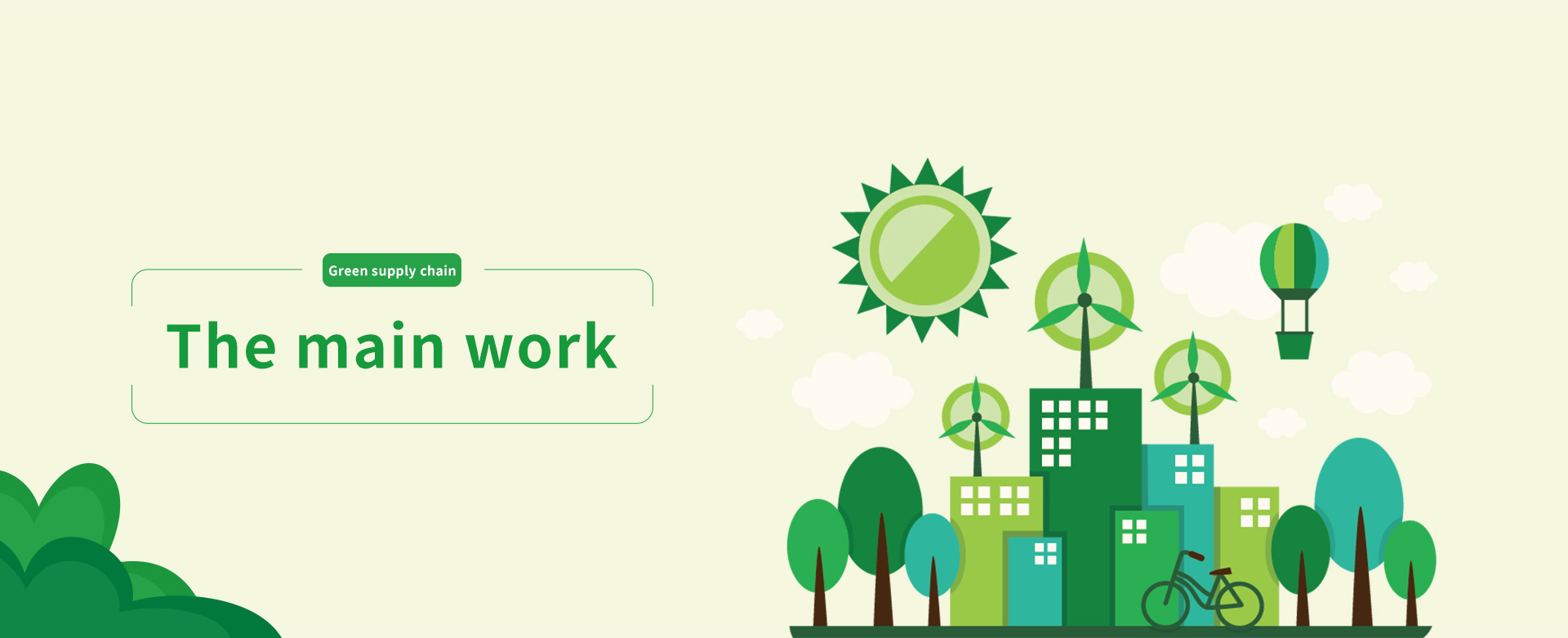 Ecological Design
Ecological Design
About “easy-to-collect & easy-to-regenerate”:
The Double E (easy-to-collect and easy-to-regenerate) Design System for Plastic Products (the Double E Design System in short), including the Double E Design Standard System, Double E Certification System, and Double E Testing System, is a systematic system formulated to guide the eco-design of plastic products and evaluate whether products are easy-to-collect and easy-to-regenerate.
Double-E Design Concept:
Double-E design is the basic principle for eco-design of plastic products, which centers on easy-to-collect & easy-to-regenerate. The concept of Double-E design originates from the 3R (Reduce, Reuse and Recycle) principle of circular economy. Core problems in plastics recycling include difficulty in recycling, high recycling cost, and low regeneration value. The Double-E design system is a set of green design system based on the pain points of the industry, the application field of plastic products, and the latest progress in technology. We put forward the new 3A concept (Available, Acceptable, Affordable), which means that the green innovation technology and business model of plastics industrial chain are Available; the social, environmental and economic impacts of plastic products in the process of production, consumption and waste disposal are Acceptable; and the cost increase brought by the implementation of eco-design and green transformation of industrial chain is Affordable. Being easy-to-collect and easy-to-regenerate is the basic guarantee to realize the recycling and sustainable value of waste plastics.
Purpose of Double-E design Standard
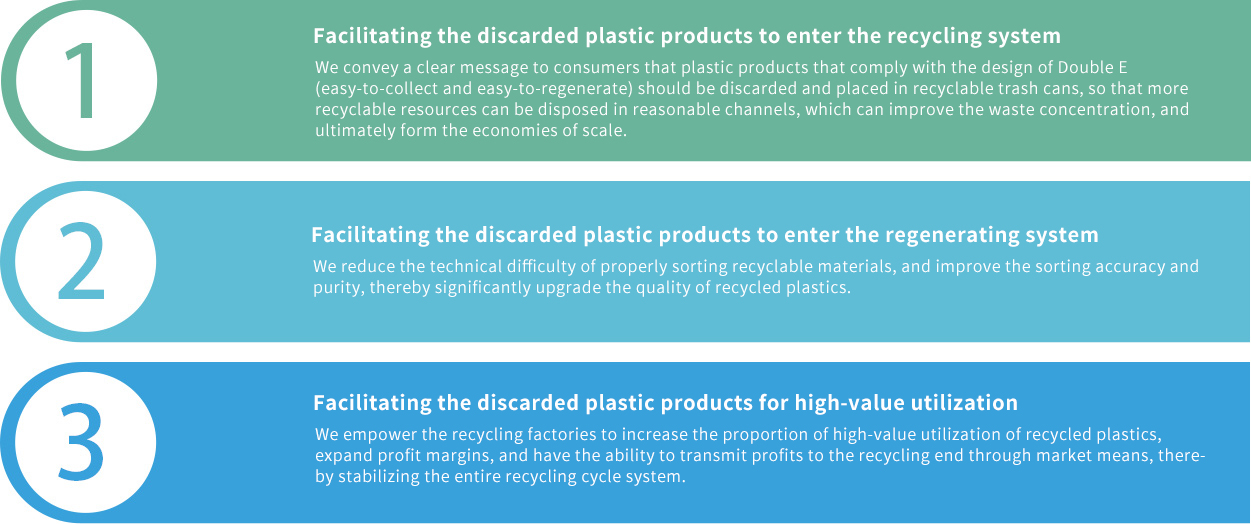
Overall objective of Double-E design Standard:
It aims to lead the green development of the plastic industry chain by standardizing the eco-design of plastic products.
Formation of Double-E System:
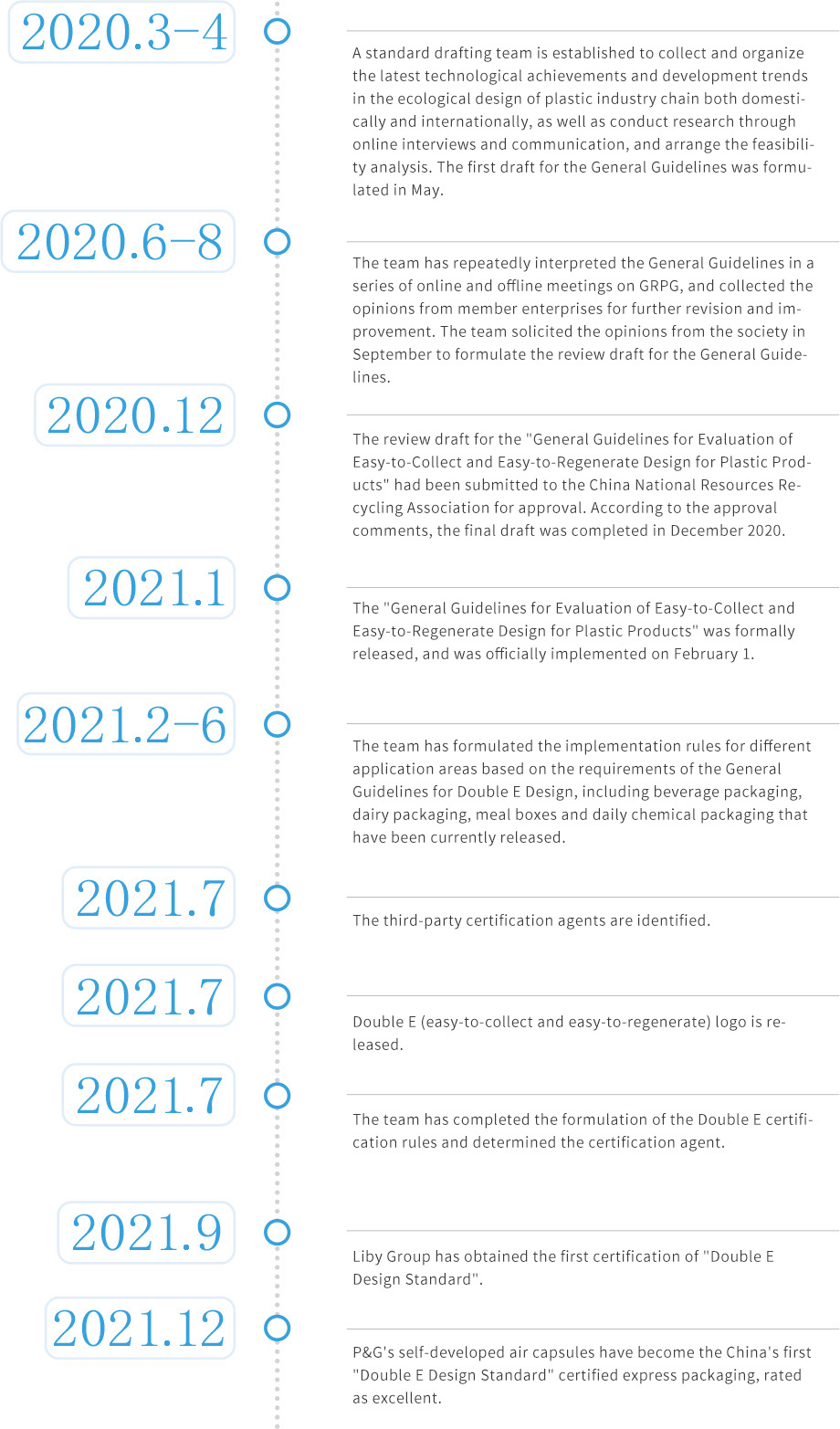
To promote the green transformation of plastics industrial chain by standardizing the eco-design of plastic products.
Double-E Design Features:
Innovative and tailored:The Double-E Design Standard was developed based on the actual situation of China, with full consideration of the advantages of domestic plastics industrial chain such as extensive coverage and mature technology. Referring to national standards of China, this standard is highly readable as the first eco-design standard on plastic products in China.
Extensive:The Double-E Design Standard is developed by joint efforts of the most representative leading enterprises and the most authoritative academic institutions in China involved in the whole industrial chain of plastics industry, including manufacturers, brand owners, consumers and recycling enterprises. With full consideration and of the demands of all links in the industrial chain, this standard features full and universal representativeness.
Systematic:The “Double-E Design” standard is a standard system including a series of general guidelines (provisions) and detailed rules which apply to most types of plastic products. The general guidelines serve as umbrella standards for the plastics industry, taking into account the compatibility and potential for cross-disciplinary applications in a comprehensive manner. The detailed rules are categorized based on the types of plastic products. The evaluation indexes are determined according to the shared characteristics of the application scenarios, and corresponding scores are assigned.
Quantifiable:The Double E Design Standard consists of five sections for plastic product eco-design including main materials, accessory materials, easy-to-collect, easy-to-regenerate, environmental friendliness and safety, with assigned sub-items. This forms a quantifiable indicator system which can precisely guide the enterprises in the eco-design.
Third-party certifiable:The “Double-E Design” standard is supported by corresponding certification and testing systems, which facilitate the popularization and practice of the standard
Double-E Design General Standards:
General Guidelines for Double-E Design Standard:The general guidelines of Double-E design include the scope, normative references, terms and definitions, evaluation index system, and evaluation methods.
The general guidelines stipulate the evaluation index system and evaluation methods for the easy-to-collect and easy-to-regenerate designs of plastic products, which are used to guide the eco-design and evaluation process of plastic products. The general guidelines are not applicable to degradable plastic products and plastic products listed in the Directory of National Hazardous Wastes.
The evaluation index system consists of primary and secondary evaluation indexes. Among them, there are five primary evaluation indexes, including main materials, accessory materials, easy-to-collect, easy-to-regenerate, environmental friendliness and safety. Secondary indexes are aligned with the primary ones and employ either quantitative or qualitative indexes based on the prevailing industrial context, resulting in a total of 27 items.
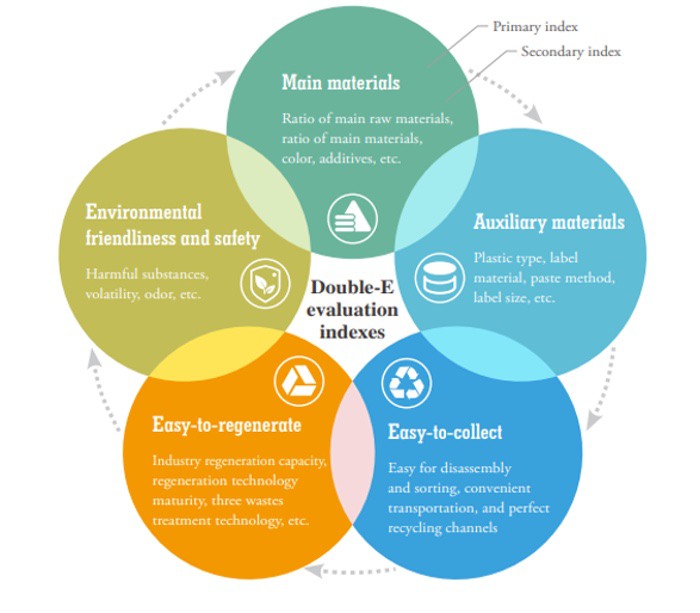
 Main materials
Main materials
The main materials selected for plastic products will bring a series of impacts in the recycling process. This includes (1) impact on the consumers' correct identification and classification of materials; (2) impact on waste intensity, concentration, and transportation costs; (3) impact on the efficiency and effectiveness of selection, material separation and sorting; (4) impact on the quality of recycled plastics; (5) impact on high-value utilization rate; and (6) impact on processing costs and profit margins. The main material is the primary factor for recycling and regeneration, and its related indicators are decisive to the quality of recycling and regeneration, which is also the core consideration element of the Double E Design Standard. The main material design includes but is not limited to material composition, proportion of main materials in product, color, proportion of recycled materials used, and proportion of additives used.
Material composition: The mono-material or compatible and non-cross-linked materials are the best options. The value of recycling and regeneration depends on the mono-material. Mono-material means a higher the recycling value.
Proportion of main materials in product: The proportion of main material weight to the total weight of plastic products shall be increased as much as possible. The higher the proportion of main materials, the higher the yield of recycled products, and the higher the recycling value per unit weight.
Color: The materials in natural colors are advocated, which can expand the diversity of recycled plastic application scenarios.
Proportion of recycled materials used: The recycled plastics are recommended as raw materials in suitable application scenarios, so that more recycled plastics can be recirculated to the plastic material cycle.
Proportion of additives used: It is necessary to minimize the use of additives while meeting the performance requirements of product, which is beneficial for the quality stability of recycled plastics in the future.
 Accessory materials
Accessory materials
Accessory materials are important supplements to meet the functional requirements of plastic products, usually with different usage requirements or functions from the main material. Accessory materials generally become by-products and impurities when reprocessed. In this context, the accessory materials should be designed that are not affecting the recycling of main material as much as possible. Accessory material design indicators include but are not limited to label size, label material, label pasting method, non-plastic materials, and types of plastic materials.
Labels: The design without label is the best option. Alternatively, the minimized labels or small labels, or laser engraving labels are suggested. The materials without affecting the recycling of main material are recommended. The materials that are compatible with the main material or have compatible properties for the label are suggested, without non-plastic materials as much as possible. The adhesive-free labels are proposed, which can be easily peeled off or shrunk to remove through grinding, cleaning and floating. The easily strippable water-soluble adhesives are priority.
Other accessory materials shall adhere to the same principles as the main materials, without non-plastic materials (paper, metal, etc.) used as much as possible.
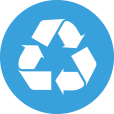 Easy-to-collect
Easy-to-collect
The easy-to-collect design includes but is not limited to indicators such as recycling channels, weight/volume/area, transportation, etc.
Recycling channels: The materials with high industry acceptance and recognition, sound recycling channels and a certain recycling scale are advisable, which can reduce the inability to recycle due to insufficient front-end collection capacity or technical limitations.
Weight/volume/area: The principle of facilitating collection and sorting should be followed. The evaluation of weight/volume/area has a significant impact on transportation capacity and recycling facilities. Plastic products shall be designed pursuant to the Guidelines for Easy-to-Collect and Easy-to-Regenerate Design of Plastic Products | Double E Design Standard System | 15 Recycling Facilities and Transportation Costs at the target consumer areas.
Transportation: The structure with easy compression and reduced capacity is best for plastic products to improve the transportation efficiency of single vehicle.
 Easy-to-regenerate
Easy-to-regenerate
The easy-to-regenerate design focuses on the principle that the plastic product design is consistent with the existing industry recycling capabilities.
The easy-to-regenerate design includes but is not limited to regenerative capacity, regeneration ratio (yield rate), maturity of regeneration technology, difficulty of label removal, sorting index, difficulty of cleaning, wastewater/exhaust gas/waste residue treatment technology, and other indicators.
Regenerative capacity: The industry's regenerative capacity needs to be considered. The materials with sufficient processing capacity should be selected. The product design should meet the target consumer's renewable production capacity, which can avoid resource waste due to insufficient production capacity.
Regeneration ratio (yield rate): An increase of regeneration ratio is advisable. The yield rate is a factor that considers the technological/equipment level of recycling enterprises, and also an indicator of the resource conversion rate from waste plastics to recycled plastics. The losses during the regeneration can be reduced while improving this indicator.
Maturity of regeneration technology: Priority should be given to plastic materials with mature regeneration technology that is regarded as an indicator based on the regeneration capacity of the target consumer area. The mature regeneration technology represents less energy consumption and material loss.
Difficulty of label removal: The difficulty of label removal should be considered. The removal of labels is a common issue in the recycling process, which directly affects the quality of recycled plastics.
Sorting index: The difficulty of sorting when recycling waste plastics of mixed materials or mixed colors should be considered. The sorting index is also an important indicator that determines the quality and purity of recycled plastics. The higher the accuracy of color sorting, the higher the purity of recycled plastics, which can reduce the possibility of adjusting the color of recycled plastic particles through color master batch such as carbon black. This reserves more options for downstream recycled applications.
Difficulty of cleaning: The easy-to-clean design for recycling is advisable. Cleaning is an important step in the mechanical recycling of plastic waste, and also another important guarantee for the purity of recycled plastics. Cleaning includes cold washing, hot washing, alkaline washing, etc. Multiple cleaning is subject to downstream purity requirements and profit margins. The nationally recommended treatment technologies are appropriate for treatment of wastewater, exhaust gas and waste residue, which is an important measure for the plastic recycling industry to reduce secondary pollution.
The nationally recommended treatment technologies are appropriate for treatment of wastewater, exhaust gas and waste residue, which is an important measure for the plastic recycling industry to reduce secondary pollution.
 The environmentally-friendly and safe
The environmentally-friendly and safe
The environmentally-friendly and safe principle shall always be applicable in the entire life cycle of plastics, and even to the next life cycle after recycling and regeneration.
In this context, the use of toxic and harmful substances in plastic products shall bestrictly restricted.
The treatment technology used for the wastewater, exhaust gas and waste residue generated during the plastic recycling shall also be strictly controlled.
All these can minimize the environmental impact of plastic products throughout their entire life cycle. The environmentally-friendly and safe, volatile gases should comply with GB/T 37866. The VOCs limit values set in Table 1 with reference to GB/T 37866 are consistent with requirements for green products, but are more stringent. This is beneficial for the quality of recycled plastics.
Printing ink: The non-toxic and harmless printing ink is advisable to avoid the transfer of toxic substances into recycled plastics.
Adhesive: The non-toxic and harmless adhesive is suggested to avoid the transfer of toxic substances into recycled plastics.
Halogen free requirements: The bromine content should be less than 900ppm, the chlorine content should be less than 900ppm, and the total amount of bromine and chlorine should be less than 1500ppm. They are set based on the RoHS directive, but are stricter than the RoHS directive. This can improve the quality of recycled plastics.
Heavy metals: The content of heavy metals should comply with GB/T 37866. The heavy metal limit values set in Table 1 with reference to GB/T 37866 meet the requirements of green products. This can avoid the transfer of heavy metals into recycled plastics, as it may result in a sustained impact on the environment.
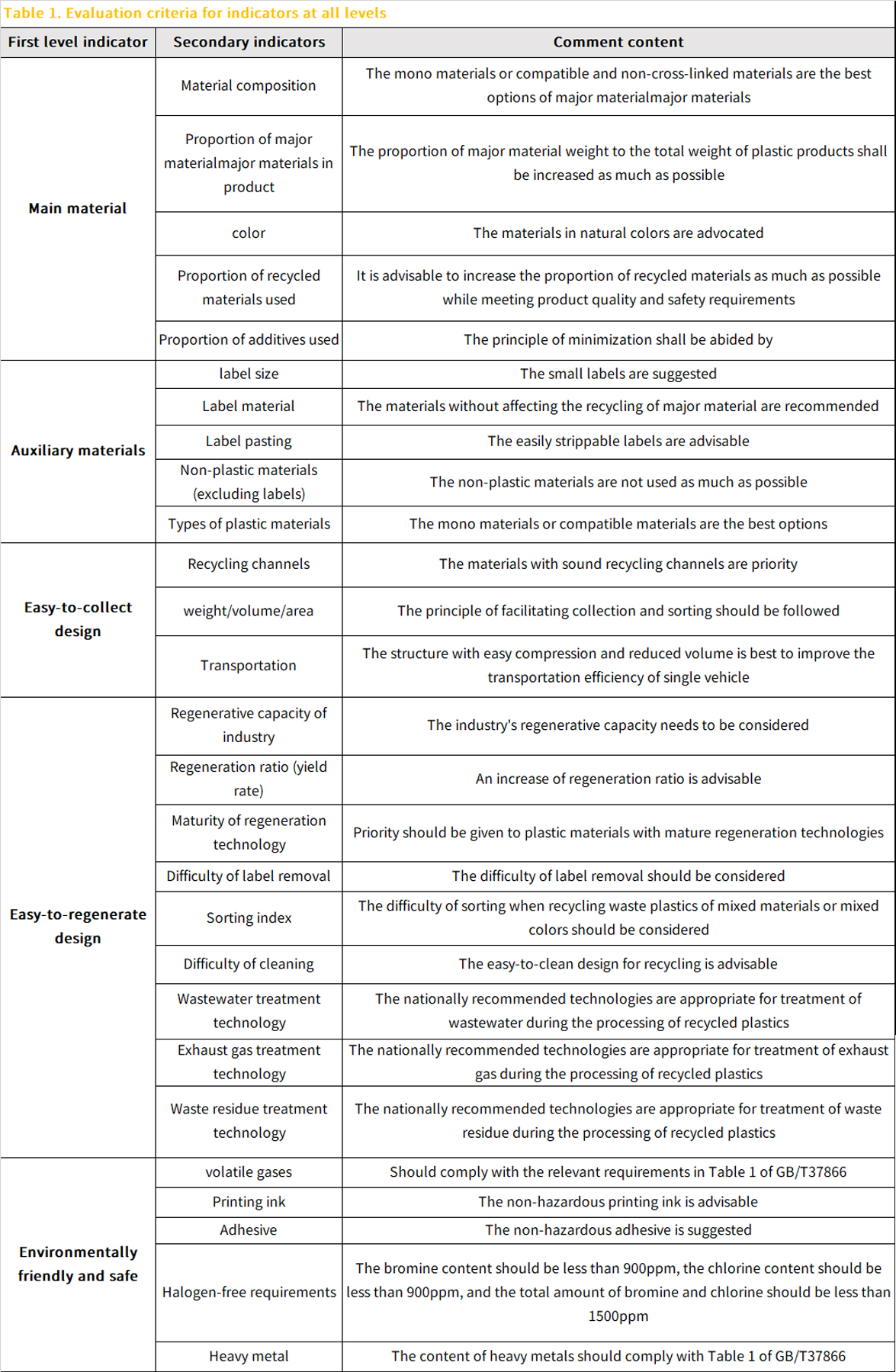
Detailed Rules of Double-E Design:
The detailed rules of Double-E design are a quantitative standard for the implementation of the general guidelines in various application fields. According to the requirements of the general guidelines, four items are set, namely, primary indexes, secondary indexes, evaluation content, and the corresponding assigned score. Primary indexes are the five major items of the general guidelines. The second-level indexes are formulated according to the general guidelines, which can be consistent with the general guidelines or be modified according to the characteristics of the application field of plastic products. Evaluation contents can be adjusted according to the characteristics of the field. The corresponding assigned score is the quantitative core of the evaluation, and different scores are set according to the evaluation contents.

Segmentation of Detailed Regulations of Double E Design:
A combination of general guidelines and detailed regulations is adopted for the Double E Design Standard. Based on the common and characteristic principles of eco-design for plastic products, a total of four major application sectors are preliminarily specified for plastic products, namely primary packaging, secondary packaging, engineering, and agricultural construction. Each sector is further composed of specific application directions. On this basis, the Double E evaluation rules are formulated for each sector.
The segmentation of applications is subject to the principle of maximal categories and minimal overlap. The materials, forms, production processes, performance requirements, market size, and other factors should be taken into account.
The segmentation application depends on the principle of large quantity and concentration, which is compatible with the process requirements of regeneration and can expand with market changes.
To formulate the detailed regulations of Double E Design Standard for various applications, GRPG sets a batch of application groups in different segmentations.
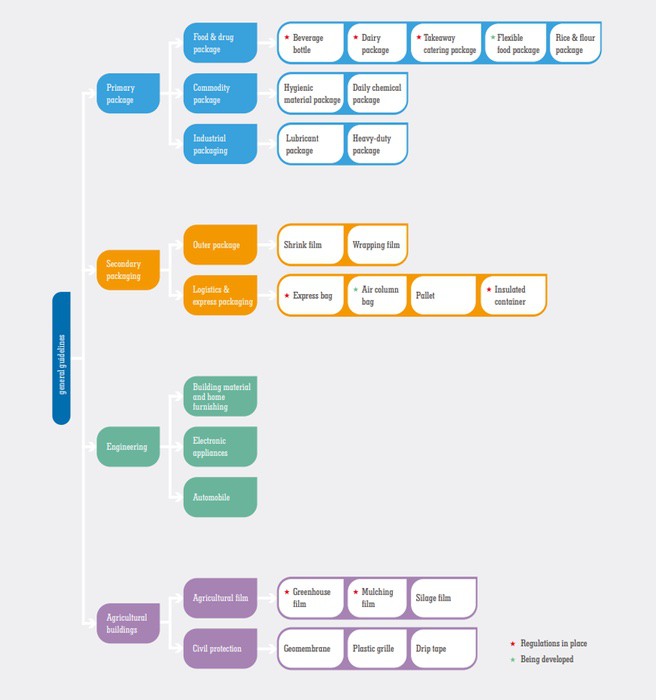
How to proceed Double E design:
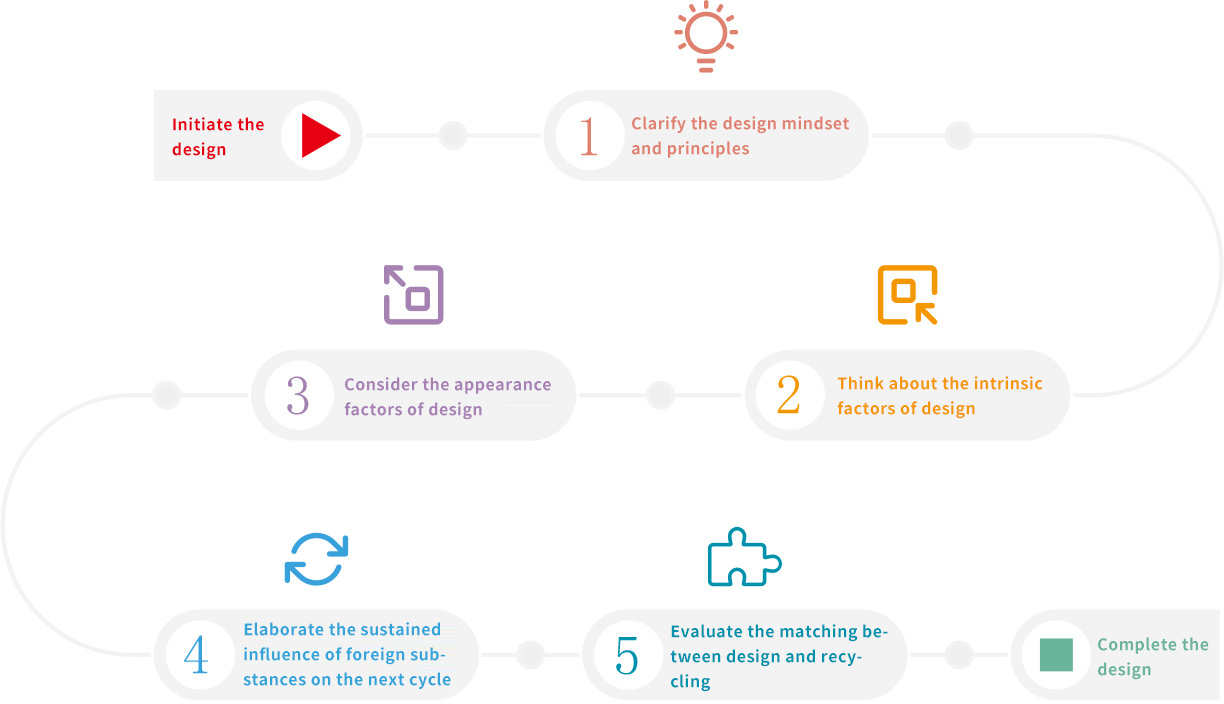
Clarification of design concept and principles
The plastic products should be designed pursuant to the "concept based on recycling and regeneration". Prior to design, we should first clarify that "recycling and regeneration" is an integral part of product design.
Plastics itself can be recycled. However, the difficulty of plastic recycling may vary due to differences in design. One of the core principles of eco-design is that products can be easily recycled and regenerated through design.
Consideration for intrinsic factors of design
The selection of materials is an intrinsic factor of design.
Several issues should be considered prior to selection:
(1) Is it possible to use a mono-material to meet the functional requirements of product (or packaging)?
(2) If not, how many materials are needed at least?
(3) Is the mono-material known and easily recyclable or widely used in the industry?
(4) If not a mono-material, are these materials known and easily recyclable?
(5) If not a mono-material, do the selected materials have compatibility enough to ensure that they are not necessarily disassembled and separated before recycling?
(6) Is it necessary to use multi-layer composite for materials? Are there any other alternatives? Or is there a ready-made disposal for the selected composite?
(7) Is there higher recycling value for the selected material?
When answering these questions, we should be clear what the reason is for doing so. This is because that:
(1) The quality and value of recycled plastics are the key drivers for recollect and regeneration. The more mono the material, the easier to sort it out during recycling. For a mono-material, a separation process is not requested before recycling, while the quality of the recycled plastics generated is excellent.
(2) The high popularity of materials ensures a more sufficient recycling capacity, a more guaranteed recycling rate, and a more stable recycling value.
(3) Rare materials or poorly compatible materials may not be effectively recyclable due to the lack of mature recycling channels and technologies, as well as the inability to cover collection/sorting costs.
(4) Most multi-layer composite materials are less compatible, and even many of them are not made of plastics. This technically and economically causes difficulties for recycling and disposal.
Therefore, the compatibility between the selected materials and recycling channels should be considered first when designing plastic products.
Reflection on appearance factors of design
Appearance is another factor to be considered for design of plastic products, which includes the coverage and area of information carriers such as color, coating, size and labels. These factors will affect the recycling process and results. Therefore, it is important to follow three principles for design:
(1) Easy to recognize
(2) Easy to transport
(3) Easy to sort
Designers should be aware that color, coating and label information can affect the identification of products and packaging. Many products are designed based on the consumer's perception, such as what color to use, whether to use external coatings, and providing consumers with more product information and brand promotion. However, for the recycling system, the sorting personnel and equipment are likely unable to correctly identify the specific materials of products in these designs, as it may cause that plastic waste cannot be properly treated in the recycling system. The information provided by the label may not necessarily ensure that consumers are aware of whether the product is recyclable, so that they cannot be guided to correctly dispose of discarded products in recyclable trash cans.
Therefore, designers should consider that:
(1) Try to use the original color of material as much as possible that consumers, sorting workers and sorting equipment can easily identify.
(2) Minimize the use of coatings that affect identification as much as possible.
(3) Moderately use the labels, and provide the recycling guidance information that is easily identifiable.
04 Thinking on the sustained impact of additives on next cycle
It is usually necessary to use the additives for purpose of improving the performance of plastic products. Due to the fact that additives will enter the next cycle with the recycling process, designers should follow the principles of safety, environmental protection and improvement of recycling value, to minimize the proportion of additives used while meeting the performance requirements of plastic products.
Both safety and environmental friendliness are the most important considerations for using additives. This includes:
(1) Toxic and harmful substances cannot be used. That is, residues of heavy metals/limiting substances/VOCs must meet the corresponding national standards.
(2) The transfer of substances such as dyes and ink in labels through the recycling process may limit the application scenarios of recycled plastics and seriously reduce their value. Therefore, the designers should consider the necessity of using dyes or purposefully determine the downstream application scenarios with more mature requirements of specific colors. To reduce the possibility of ink mixing, the labels should be removed as much as possible during the pre-treatment process before recycling.
Evaluation on consistency between design and recycling
The consistency between design and recycling can be evaluated in accordance with the "Evaluation on Easy-to-Collect and Easy-to-Regenerate Design of Plastic Products" (Double E Design Evaluation). Both qualitative and quantitative results can be obtained. In the Double E Design Evaluation, the higher the consistency between design and recycling channels, the higher the score given. Therefore, the production enterprises can be encouraged to optimize product design, ensure that their products can be easily recycled and properly disposed. The high-value utilization can be achieved by realizing and improving the value of recycling. We can create and expand commercial recycling models, ensuring that the easy-to-collect and easy-to-regenerate design is of greater practical significance. Therefore, more plastic products can be shifted from linear economic models to circular economic models.
Double-E Certification Process:
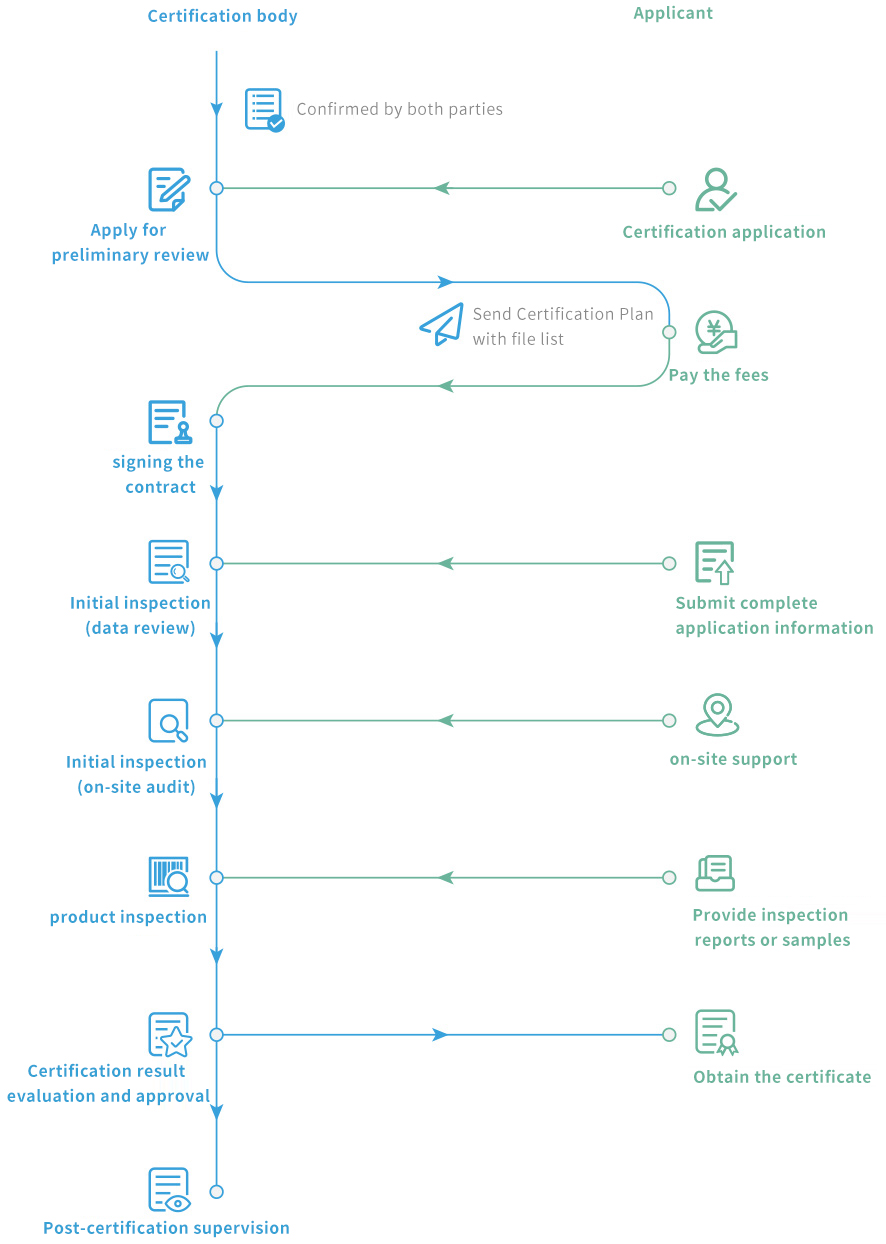
The role of Double E Certification:
The Double-E certification holds great significance for brand owners, raw material suppliers, product suppliers, recyclers, and consumers alike. It serves as a vital tool in promoting eco-design, facilitating the implementation of cleaner production practices, achieving carbon peaking and carbon neutrality goals, supporting the healthy and sustainable development of compliant enterprises while preventing the “Bad money drives out good”.
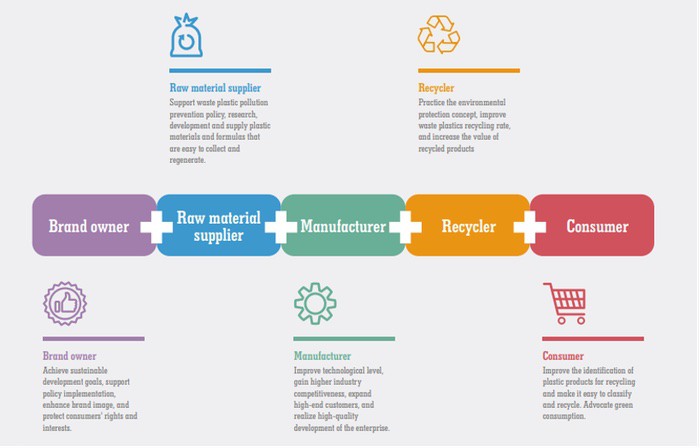
Labelling of Double-E Design:
In July 2021, GRPG Working Group released the labels of easy-to-collect and easy-to-Regenerate (hereinafter referred to as the “Double-E label”). The Double-E label takes the Chinese character “回” as the main design body, the blue color of recyclables in waste classification as the primary color, and the two counterclockwise arrows as collecting and regenerating plastics. The Double-E label signifies that the design of plastic products adheres to the standards for easy-to-collect and easy-to-regeneration, making it the exclusive emblem for easy-to-collect and easy-to-regenerate plastic products
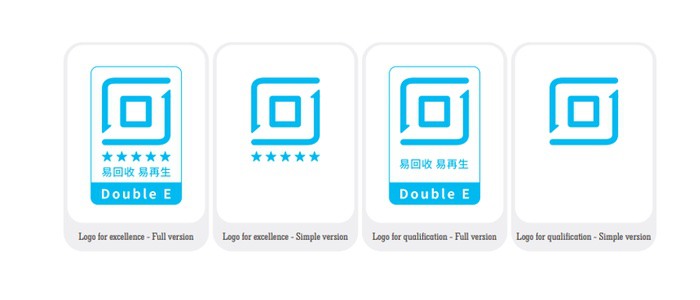
After evaluation according to the Double E evaluation system, it can be rated as excellent and qualified based on the score. Both meet the requirements of the Double E Design Standard. It means that the excellent product has excellent performance in the comprehensive evaluation. The identification is shown in the above figure.
According to the "Management Measures on Use of Easy-to-Collect and Easy-to-Regenerate Logos for Plastic Products", unless otherwise required by relevant institutional schemes or certification agencies, enterprises can independently choose any production process (such as printing and molding) to use or display the Double E Logo in the product body, nameplate, outer packaging, attached documents (such as manuals and certificates of conformity), operating system, electronic sales platform, product brochure, and other locations. The complete version of the Double E logo should be used. Alternatively, enterprises can use a simplified version due to design, process requirements, or other reasons.
Certification Body of Double-E Label:
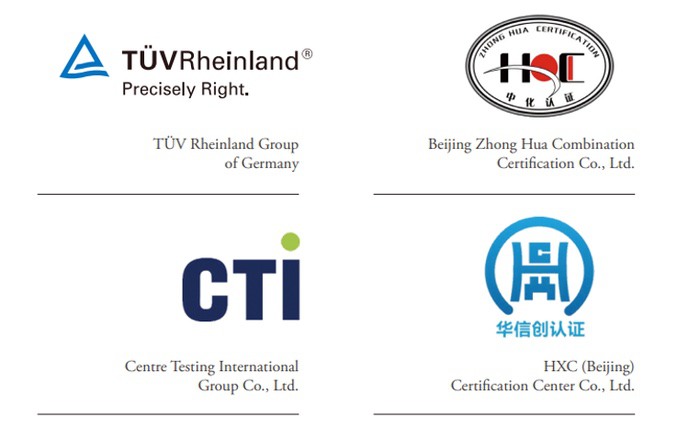
Double-E Certification Achievements:
In less than four years after the official implementation of the "General Guidelines for Evaluation of Easy-to-Collect and Easy-to-Regenerate Design for Plastic Products" on February 1, 2021, a number of raw material suppliers, brand owners, plastic product manufacturers and recyclers in the plastic industry have actively practiced and promoted the standards, and have achieved initial success. Currently, there are more and more brands and enterprises that have obtained Double E certification and can use the Double E logo in their products. In addition, led by Meituan, the implementation rules for take-out packaging are formulated, and the Double E Design Standard is taken as the screening criteria for its take-out food box suppliers.
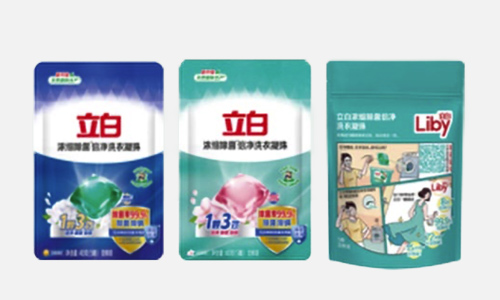


What we prospect:
GRPG will continue to improve its standard system and introduce more implementation rules in various areas; increase the publicity efforts of Double E and expand its influence; arrange international exchanges, and promote mutual recognition between international standards and Double E; and establish a plastic product recycling system based on Double E Design. In addition, GRPG will continue to promote the Double E certification and improve the construction of testing system. On this basis, GRPG hopes to improve the Double E system and promote the practical work, thus contributing to the recycling and utilization of waste plastics as well as the prevention and control of plastic pollution in China and even the world.




